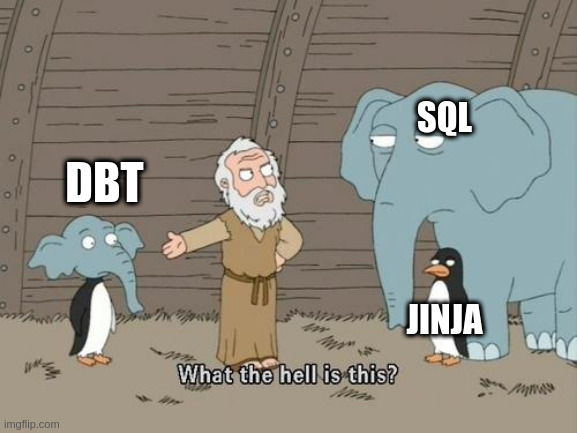- Principle: Analytics as software, authored by anyone who knows SQL
- Long-term strategy of independence: Lock-in prevents individual technologists from making choices about what the best technology is for a given use case. https://blog.getdbt.com/of-the-community-by-the-community-for-the-community/
- It's a framework with an opinion. And some more advanced ideas, like the Analytics Development Lifecycle (ADLC) (which copied SQLMesh, I suppose)
- https://github.com/slve/dbt-github-workflow
- Cheat Sheet
- dbt libraries
- https://docs.getdbt.com/blog
- A curated list of awesome dbt resources
- What is dbt?
- Paid course
- Key blog posts
- Fundamentals?
- Github
- COALESCE Conference
- https://discourse.getdbt.com/t/how-we-set-up-our-computers-for-working-on-dbt-projects/243
- Materialisation types
- Serverless dbt on Google Cloud Platform
- https://atom.io/
- https://github.com/smomni/howtheydbt
- https://www.youtube.com/watch/zc8wLzoAkVc
- http://zsh.sourceforge.net/Doc/Release/Prompt-Expansion.html
- https://discourse.getdbt.com/t/your-essential-dbt-project-checklist/1377
- https://discourse.getdbt.com/t/why-the-fishtown-sql-style-guide-uses-so-many-ctes/1091/10
- https://gitlab.com/gitlab-data/analytics/-/blob/master/transform/snowflake-dbt/macros/utils/simple_cte.sql
- https://www.youtube.com/channel/UCVpBwKK-ecMEV75y1dYLE5w/videos?view=0&sort=p&flow=grid
- https://courses.getdbt.com/courses/fundamentals
- Slack Community
- Learning on Demand
- Locally Optimistic
- Blog for current and aspiring data analytics leaders
- Benn Substack
- dbt blog
- https://technically.dev/posts/what-your-data-team-is-using
- https://victorcouste.github.io/data-tools/
- https://www.getdbt.com/analytics-engineering/
- https://towardsdatascience.com/data-stacks-for-fun-nonprofit-part-iii-dcfd46da9f9f
- https://discourse.getdbt.com/t/why-the-fishtown-sql-style-guide-uses-so-many-ctes/1091
- https://discourse.getdbt.com/t/writing-models-backwards-an-unorthodox-approach-to-data-transformation/2287
- https://materialize.com/
- https://hub.getdbt.com/
- https://hub.getdbt.com/tailsdotcom/dbt_artifacts/latest/
- https://analyticsengineers.club/
- Extra links
- https://github.com/re-data/re-data
- Refactoring SQL for Modularity
- https://tellery.io/
- https://astorik.com/
- https://github.com/fal-ai/fal
- Getting Started with dbt, demystifying terminology
- https://hightouch.io/ (Reverse ETL)
-
• ETL or Extract, Transform and Load: data moves from cloud apps to a data warehouse via a robust transformation layer built into the ETL tool
-
ELT or Extract, Load, and Transform: data moves from cloud apps to a data warehouse directly post which transformation and data modelling take place in the warehouse via SQL. The main difference here is that with ETL, transformation takes place before data is loaded into the warehouse, whereas with ELT, transformation takes place afterwards
-
Reverse ETL: data moves from a data warehouse to cloud apps. Typically, the core transformation takes place in the warehouse before the reverse ETL process, but the reverse ETL tool may have a minimal transformation layer to fit data to an external system’s schema
(https://www.hightouch.io/blog/data-integration/)
-
- https://github.com/emilyriederer/dbtplyr (dbtplyr)
What if you could actually implement your data pipelines as a graph of materialized views?
Taken far enough, the promise of such an idea would be to build a declarative data lake, where the code that manages the lake focuses more on defining what the datasets are and less on how to mechanically build or update them.
The ideas presented in this post are not new. But materialized views never saw widespread adoption as a primary tool for building data pipelines, likely due to their limitations of no support of progressive / partial updates, and ties to relational database technologies. Perhaps with this new wave of tools like dbt and Materialize we’ll see materialized views used more heavily as a primary building block in the typical data pipeline.
https://nchammas.com/writing/data-pipeline-materialized-view
{%- set my_query -%}
SELECT distinct {{pivot_column}} FROM {{my_table}} ;
{%- endset -%}
{%- set results = run_query(my_query) -%}
{%- if execute -%}
{%- set items = results.columns[0].values() -%}
{%- endif %}
Jinja uses a run_query() function, which executes SQL and returns a result object. Using the result object properties, we obtain a distinct list of column values as an array which we can then assign to a variable for subsequent use.
https://serge-g.medium.com/dynamic-sql-pivots-with-dbt-dea16d7b9b63
What is dbt?
- data build tool (dbt) is a tool that allows data analysts to adopt software engineering best practices in how they manage their data.
- The general principle is that data is ingested into the warehouse in its raw form and SQL is used with version control, testing and metadata (data dictionaries) to manage the data that lives in production. It incorporates the benefits of functional programming to ensure reproducibility and simplicity.
https://medium.com/snaptravel/how-should-our-company-structure-our-data-team-e71f6846024d

Testing in dbt
General
Basic
Coverage
Comparisons
Advanced
- Source
freshness - Using Python through
dbt-fal, e.g. advanced metadata or anomaly detection
Tools
Tools
- Turntable: view column-level lineage, edit documentation in-line, and use AI for auto-generated drafts